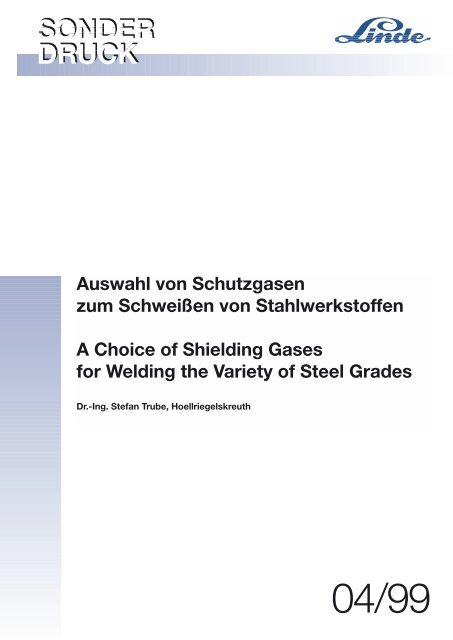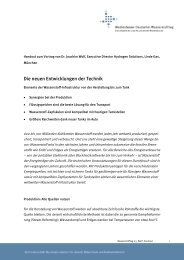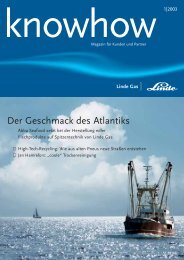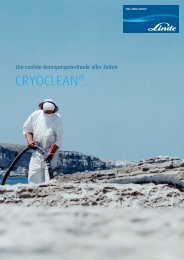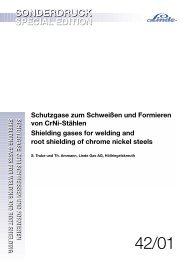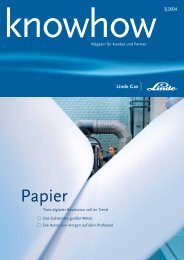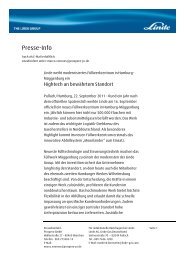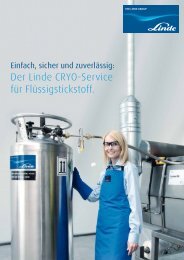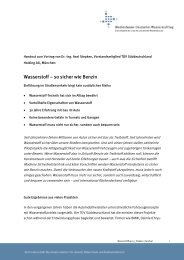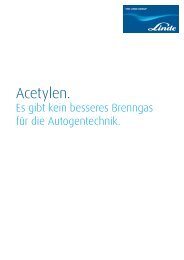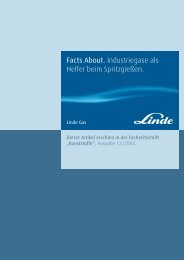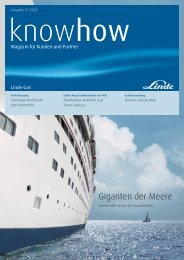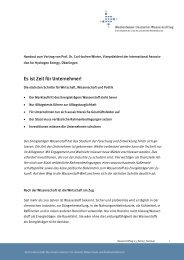Auswahl von Schutzgasen zum Schweißen von Stahlwerkstoffen A ...
Auswahl von Schutzgasen zum Schweißen von Stahlwerkstoffen A ...
Auswahl von Schutzgasen zum Schweißen von Stahlwerkstoffen A ...
Sie wollen auch ein ePaper? Erhöhen Sie die Reichweite Ihrer Titel.
YUMPU macht aus Druck-PDFs automatisch weboptimierte ePaper, die Google liebt.
<strong>Auswahl</strong> <strong>von</strong> <strong>Schutzgasen</strong><br />
<strong>zum</strong> <strong>Schweißen</strong> <strong>von</strong> <strong>Stahlwerkstoffen</strong><br />
A Choice of Shielding Gases<br />
for Welding the Variety of Steel Grades<br />
Dr.-Ing. Stefan Trube, Hoellriegelskreuth<br />
04/99
Teilweise veröffentlicht in „Jahrbuch Schweißtechnik ’99“, DVS-Verlag, Düsseldorf<br />
<strong>Auswahl</strong> <strong>von</strong> <strong>Schutzgasen</strong><br />
<strong>zum</strong> <strong>Schweißen</strong> <strong>von</strong> <strong>Stahlwerkstoffen</strong><br />
Dr.-Ing. Stefan Trube, Höllriegelskreuth<br />
Seit der Entwicklung der Schutzgasschweißtechnologie zu<br />
Beginn der 40er und 50er Jahre wurden <strong>von</strong> den Gaseherstellern<br />
zahlreiche Gasgemische für unterschiedliche Werkstoffe<br />
und Prozeßvarianten des WIG- und MSG-<strong>Schweißen</strong>s entwickelt.<br />
Um ein besseres Verständnis für die Entwicklung des<br />
Schutzgasschweißens zu bekommen, werden einleitend kurz<br />
die geschichtlichen Aspekte der Schweißprozesse und<br />
Schutzgase vorgestellt.<br />
Das erste Patent <strong>zum</strong> WlG-<strong>Schweißen</strong> wurde 1942 dem<br />
amerikanischen Flugzeugingenieur Meredith <strong>zum</strong> <strong>Schweißen</strong><br />
<strong>von</strong> Magnesium und dessen Legierungen unter Helium in den<br />
USA erteilt [1; 2]. Erst die Übernahme der Patentrechte durch<br />
Linde Air Products Company und eine entsprechende Weiterentwickung<br />
des WlG-Prozesses führte Ende der 40er Jahre zu<br />
einem größeren industriellen Einsatz des WlG-<strong>Schweißen</strong>s für<br />
Magnesium, Aluminium, Kupfer, Nickelbasis-Legierungen und<br />
hochlegierten Stählen [2; 3]. Zu diesem Zeitpunkt wurde bereits<br />
auch Argon als Schutzgas eingesetzt. In Europa wurde<br />
deshalb das WlG-<strong>Schweißen</strong> unter dem Begriff ARGONARC-<br />
<strong>Schweißen</strong> eingeführt, während es in den USA HELIARC-<br />
<strong>Schweißen</strong> hieß.<br />
Tabelle 1<br />
Einteilung der Schutzgase für das Lichtbogenschweißen nach DIN EN 439.<br />
2<br />
1950 wurde drei Amerikanern das Patent <strong>zum</strong> Metall-<br />
Schutzgasschweißen (MSG) erteilt [7; 8]. Sie schweißten Stahl<br />
und Aluminium unter dem Schutzgas Argon. Das S.l.G.M.A.-<br />
<strong>Schweißen</strong> (shielded inert gas metal arc) unter Argon als<br />
Schutzgas setzte sich sehr schnell für das Fügen <strong>von</strong> Aluminium<br />
und seine Legierungen durch. Es ist heute in Europa fast<br />
nur noch unter dem Begriff MlG-<strong>Schweißen</strong> bekannt. Jedoch<br />
konnte das Schweißergebnis beim <strong>Schweißen</strong> <strong>von</strong> unlegiertem<br />
Baustahl unter Argon-Schutzgas aufgrund deutlicher<br />
Lichtbogeninstabilitäten nicht überzeugen, Bild 1. Dieser<br />
Schwachpunkt des Prozesses wurde Anfang der 50er Jahre,<br />
durch eine 1 bis 5%ige Zumischung <strong>von</strong> Sauerstoff <strong>zum</strong><br />
Argon, behoben. Mit der Erfindung der CP-Stromquelle 1958<br />
durch Tuthill und Welsh wurden anwendungstechnische<br />
Nachteile der bis darin gebräuchlichen Stromquellen beseitigt.<br />
Im gleichen Jahr gab es das erste Patent für ein 3-Komponenten<br />
Schutzgas <strong>zum</strong> MAG-<strong>Schweißen</strong> (15% CO 2/5%O 2/<br />
80% Argon) [14].<br />
Anfang 1950 war Argon aufgrund fehlender leistungsfähiger<br />
Luftzerleger noch sehr teuer, so daß CO 2 in den USA und<br />
der damaligen UdSSR für das MSG-<strong>Schweißen</strong> <strong>von</strong> Baustahl<br />
Kurzbe- Komponenten in Volumen-Prozent übliche Anwendung Bemerkungen<br />
zeichnung 1)<br />
Gruppe Kenn- oxidierend inert reduzierend reaktionszahl<br />
träge<br />
CO2 O2 Ar He H2 N2 R 1 Rest2) > 0 ... 15 WIG reduzierend<br />
2 Rest2) > 15 ... 35 Plasmaschweißen<br />
Plasmaschneiden<br />
Wurzelschutz<br />
I 1 100 MIG, WIG inert<br />
2 100 Plasmaschweißen<br />
3 Rest > 0 ... 95 Wurzelschutz<br />
M1 1 > 0 ... 5 Rest 2) > 0 ... 5 MAG schwach<br />
2 > 0 ... 5 Rest 2) oxidierend<br />
3 > 0 ... 3 Rest 2)<br />
4 > 0 ... 5 > 0 ... 3 Rest 2)<br />
M2 1 > 5 ... 25 Rest 2)<br />
2 > 3 ... 10 Rest 2)<br />
3 > 0 ... 5 > 3 ... 10 Rest 2)<br />
4 > 5 ... 25 > 0 ... 8 Rest 2)<br />
M3 1 > 25 ... 50 Rest 2)<br />
2 > 10 ... 15 Rest 2)<br />
3 > 5 ... 50 > 8 ... 15 Rest 2)<br />
C 1 100 stark<br />
2 Rest > 0 ... 30 oxidierend<br />
F 1 100 Plasmaschneiden reaktionsträge<br />
2 > 0 ... 50 Rest Wurzelschutz reduzierend<br />
1) Wenn Komponenten zugemischt werden, die nicht in der Tabelle aufgeführt sind, so wird das Mischgas als Spezialgas und<br />
mit dem Buchstaben S bezeichnet.<br />
2) Argon kann bis zu 95% durch Helium ersetzt werden.
(a)<br />
(b)<br />
Bild 1<br />
Vergleich der Nahtoberflächen beim MSG-<strong>Schweißen</strong> <strong>von</strong> unlegiertem<br />
Stahl mit Argon (a) beziehungsweise Ar/5% O 2-Mischgas<br />
(b) im Sprühlichtbogen; die Schweißparameter sind bei<br />
beiden Schweißungen identisch, die Schweißspannung ist<br />
jedoch dem Schutzgas angepaßt.<br />
getestet wurde, mit dem Ergebnis, daß die Schweißnaht viele<br />
Poren aufwies [4; 5]. Erst die Entwicklung der Schutzgas-<br />
Drahtelektroden mit desoxidierenden Elementen (Mn, Si) <strong>von</strong><br />
Linde Air Products Company brachte 1954 den entscheidenden<br />
Schritt <strong>zum</strong> Durchbruch des MAGC-<strong>Schweißen</strong>s [3; 4; 6].<br />
In Europa wurde bis Anfang 1970 aus Kostengründen<br />
überwiegend mit reinem CO 2 geschweißt, bis die Vorteile der<br />
Ar/CO 2-Mischgase bei den Anwendern bekannt wurden. Die<br />
Markteinführung der Ar/CO 2-Mischgase dauerte, speziell in<br />
Deutschland, rund 2 Jahrzehnte. Selbst heute gibt es noch<br />
Anwendungen, bei denen bevorzugt CO 2 als Schutzgas <strong>zum</strong><br />
<strong>Schweißen</strong> <strong>von</strong> Stahl eingesetzt wird.<br />
Einen Überblick über die Technologie der Schweißschutzgase<br />
soll in den nachfolgenden Ausführungen gegeben werden,<br />
wobei aus Platzgründen nicht alle Schutzgasschweißprozesse,<br />
<strong>zum</strong> Beispiel das Plasmaschweißen, erläutert werden<br />
können. Berücksichtigung finden lediglich die Stahlwerkstoffe.<br />
Schutzgase nach DIN EN 439<br />
Seit 1994 ist DIN EN 439 gültig und ersetzt seit diesem<br />
Zeitpunkt DIN 32526 [9]. Die Bezeichnung der Schutzgase<br />
nach DIN EN 439 entsprechend ihrer Zusammensetzung ist in<br />
Tabelle 1 dargestellt, die Nomenklatur der Schutzgase soll<br />
aber an dieser Stelle nicht weiter erläutert werden.<br />
Aus Tabelle 1 wird ersichtlich, daß <strong>zum</strong> WIG- und MSG-<br />
<strong>Schweißen</strong> lediglich fünf Gaskomponenten <strong>zum</strong> Einsatz kommen,<br />
nämlich Argon, Helium, Kohlendioxid, Sauerstoff und<br />
Wasserstoff. Eine Ausnahme ist Stickstoff, der im Regelfall<br />
lediglich <strong>zum</strong> Formieren oder Plasmaschneiden eingesetzt<br />
wird, jedoch finden zur Zeit vermehrt stickstoffhaltige Gase<br />
<strong>zum</strong> Schutzgasschweißen <strong>von</strong> hochlegierten Stählen Verwendung.<br />
Anforderungen an Schweißschutzgase<br />
Die Anforderungen an Schweißschutzgase sind vielschichtig.<br />
Eine übersichtliche Aufstellung <strong>von</strong> Eigenschaften und Einflüssen<br />
der Gase wurde <strong>von</strong> Stenke in mehreren Veröffentlichungen<br />
vorgestellt [10; 11]. Diese Anforderungen gliedern<br />
sich in Anlehnung an die vorgenannten Veröffentlichungen wie<br />
folgt in:<br />
– allgemeine Anforderungen:<br />
Eignung des Gases für den ausgewählten Schweißprozess<br />
(MSG, WIG, WP),<br />
Eignung des Gases für die Lichtbogenarten<br />
(MSG-<strong>Schweißen</strong>),<br />
Schutz der Schmelze vor der Atmosphäre, <strong>zum</strong> Beispiel<br />
unabhängig <strong>von</strong> Position und Nahtgeometrie,<br />
Unempfindlichkeit gegen äußere Einflüsse, beispielsweise<br />
Verunreinigung des Bleches,<br />
Vermeidung <strong>von</strong> Schweißspritzern,<br />
– physikalische Anforderungen:<br />
lonisationsenergie,<br />
Zündverhalten bei Schweißbeginn,<br />
Bildung eines Plasmastromes,<br />
elektrische Leitfähigkeit des (Gas-)Plasmas,<br />
Lichtbogenstabilität,<br />
– thermische Anforderungen:<br />
Wärmeübertragung sowohl im Plasma- als auch im nichtionisierten<br />
Zustand,<br />
Wärmekapazität,<br />
Wärmeleitfähigkeit,<br />
– metallurgische Einflüsse:<br />
Abbrand <strong>von</strong> Legierungselementen,<br />
Zubrand <strong>von</strong> Kohlenstoff und/oder Sauerstoff und Stickstoff<br />
in die Schmelze,<br />
keine (geringe) Löslichkeit der Gase in der Schmelze<br />
(metallurgische Porenbildung),<br />
geringe Schlackenbildung,<br />
geringe Oberflächenoxidation,<br />
Erhalt der mechanisch-technologischen Gütewerte der<br />
Werkstoffe, <strong>zum</strong> Beispiel Zähigkeit,<br />
Erhalt der Korrosionsbeständigkeit.<br />
Die Liste der Anforderungen ist sicherlich nicht vollständig,<br />
die Komplexität der Ansprüche an Schweißschutzgase wird<br />
daraus jedoch schon ersichtlich. Die Erfüllung aller Anforderungen<br />
bei einer Schweißaufgabe ist in der Regel nicht möglich<br />
und endet häufig in einem technischen Kompromiß.<br />
Eigenschaften der Schutzgaskomponenten<br />
Stichpunktartig werden nachfolgend die wichtigsten physikalischen<br />
Eigenschaften der Schutzgaskomponenten vorgestellt.<br />
Diese Eigenschaften wirken sich entsprechend der Konzentration<br />
des Gases mehr oder minder stark auf den<br />
Schweißprozess aus.<br />
Ar: – inertes Gas, das heißt keine Reaktion mit dem<br />
Werkstoff,<br />
– schwerer als Luft � Schutz der Schmelze<br />
vor Luftzutritt<br />
– leicht zu ionisieren � Zündung des Schweißprozesses<br />
wird erleichtert.<br />
He: – inertes Gas, das heißt keine Reaktion mit dem<br />
Werkstoff,<br />
– leichter als Luft � gegenüber Ar höherer Volumenstrom<br />
<strong>zum</strong> Schutz der Schmelze erforderlich,<br />
– hohes lonisationspotential � Lichtbogenzündung mit<br />
steigendem He-Anteil erschwert,<br />
3
4<br />
– hohes lonisationspotential � höhere Schweißspannung<br />
erforderlich<br />
– hohe Wärmeleitfähigkeit und lonisationspotential<br />
� hoher Wärmeeintrag in Grundwerkstoff,<br />
– hoher Wärmeeintrag � bessere Benetzung, breiterer<br />
Einbrand, flachere Naht, teilweise höhere Schweißgeschwindigkeit.<br />
CO 2:–aktives Gas, das heißt Reaktion mit dem Werkstoff<br />
(Oxidation),<br />
– Lichtbogenstabilisierung durch CO 2,<br />
– schwerer als Luft � Schutz der Schmelze vor<br />
Luftzutritt,<br />
– dissoziiert im Lichtbogen zu CO + O � Volumenanstieg<br />
� besserer Schutz der Schmelze,<br />
– nach vollständiger Dissoziation oxidierende, in geringem<br />
Umfang aufkohlende Wirkung,<br />
– hohes lonisationspotential � Zündung erschwert,<br />
hoher Wärmetransport,<br />
– Rekombination <strong>von</strong> CO + O zu CO 2 � extreme Wärmefreisetzung<br />
� sicherer (breiter) Einbrand,<br />
– Rekombination und hohe Schweißspannung � höhere<br />
Schweißgeschwindigkeit,<br />
– wichtigste Gas-/ Zumischkomponente zur Reduktion<br />
der Porenhäufigkeit im Schweißgut,<br />
– mit steigendem CO 2-Gehalt � höhere Spritzerbildung,<br />
speziell im Langlichtbogen,<br />
– oxidierende Wirkung � Schlackenbildung nimmt mit<br />
steigendem CO 2-Anteil zu.<br />
O 2: – aktives Gas, stark oxidierende Wirkung (2- bis 3mal<br />
höher als CO 2),<br />
– lichtbogenstabilisierende Wirkung,<br />
– reduziert die Oberflächenspannung <strong>von</strong> Stahl � sehr<br />
spritzerarme, feinschuppige Nähte,<br />
– geringe Oberflächenspannung bei Stahl � in Fallnaht<br />
vorlaufende Schmelze (Gefahr <strong>von</strong> Bindefehlern!),<br />
– porenempfindliches Schutzgas,<br />
– geringes lonisationspotential � geringe Schweißspannung<br />
� geringer Wärmeeintrag.<br />
H 2: – aktives Gas, reduzierende Wirkung,<br />
– hohes lonisationspotential und hohe Wärmeleitfähigkeit<br />
� sehr hoher Wärmeeintrag in Grundwerkstoff,<br />
– Lichtbogen wird durch H 2 eingeschnürt � hohe<br />
Energiedichte des Lichtbogens,<br />
– Wärmeeintrag und Lichtbogeneinschnürung<br />
� Steigerung der Schweißgeschwindigkeit,<br />
– bei bestimmten Bedingungen Gefahr der Riß- und<br />
Porenbildung bei unlegierten Stählen,<br />
– mit steigendem H 2-Anteil Gefahr der Porenbildung bei<br />
austenitischen Chrom-Nickel-Stählen.<br />
N 2: – reaktionsträges Gas, das heißt Reaktion mit Metall nur<br />
bei hohen Temperaturen, bei geringen Temperaturen<br />
inertes Verhalten, das heißt keine Reaktion,<br />
– ist Porenbildner bei <strong>Stahlwerkstoffen</strong>,<br />
– führt zur Alterung (Versprödung), Problem speziell bei<br />
Feinkornbaustählen,<br />
– Austenitbildner, unterdrückt teilweise die Ferritphase,<br />
<strong>zum</strong> Beispiel bei Vollausteniten.<br />
Unterschiedliche Stahlwerkstoffe und die zu<br />
verwendenden Schutzgasgemische<br />
� MAG-<strong>Schweißen</strong> <strong>von</strong> unlegiertem Stahl<br />
Ar: Wie bereits in der Einleitung vorgestellt, brennt ein Schutzgaslichtbogen<br />
ohne O 2/CO 2-Schutzgasanteile instabil und<br />
unruhig, was zu einer erhöhten Porenanzahl und mangelhaftem<br />
Nahtaussehen führt. Aufgrund des fehlenden O 2/CO 2 ist<br />
die Stahlschmelze sehr zähflüssig, was zu einem sehr<br />
schlechten Nahtbild führt (Randkerben, Schuppung, Überwölbung).<br />
Ar/O 2: Seit der Entwicklung des MAG-<strong>Schweißen</strong>s sind<br />
Ar/O 2-Mischgase mit bis zu 5% O 2 bekannt. Jedoch wurde<br />
der insbesondere bei Fallnähten ungenügende Einbrand und<br />
die Porenempfindlichkeit dieses Gasgemisches bemängelt.<br />
Um die Porenempfindlichkeit zu reduzieren, wurden die O 2-<br />
Gehalte auf 8 bis 12% angehoben. Diese hoch sauerstoffhaltigen<br />
Gasgemische finden heute noch bei verschmutzten und<br />
verzunderten Stahlblechen Anwendung. Die nachteiligen<br />
Eigenschaften der sauerstoffhaltigen Gasgemische wie mangelhafter<br />
Einbrand in Fallnahtposition und Schlackenbildung<br />
verstärken sich aber gleichzeitig. Oberhalb 8% O 2 wird die<br />
Nahtoberfläche zunehmend rauher, die Oberfläche sieht „verbrannt“<br />
aus.<br />
Sehr gut bewährt haben sich sauerstoffhaltige Schutzgase<br />
(4 bis 5%) beim <strong>Schweißen</strong> dünner Bleche in Normalposition<br />
(PA oder PB), hier ist die wichtigste Anforderung die Spritzerarmut<br />
der Schweißung. Ein weiterer Vorteil ist die bessere<br />
Spaltüberbrückbarkeit der Ar/O 2-Gemische.<br />
CO 2: Besonders beim <strong>Schweißen</strong> im Kurzlichtbogen, also bei<br />
geringen Leistungen, kann die hohe Wärmeeinbringung des<br />
CO 2, <strong>zum</strong> Beispiel bei der Fallnahtschweißung, sehr gut in<br />
hohe Schweißgeschwindigkeiten umgesetzt werden. Dabei ist<br />
die Spritzerhäufigkeit nicht nennenswert höher als bei den<br />
Mischgasen. Erst bei höherem Drahtvorschub nimmt die<br />
Spritzerhäufigkeit zu.<br />
Auch heute noch gibt es zahlreiche Anwendungsfälle bei<br />
denen auf CO 2 als Schutzgas nicht verzichtet werden kann,<br />
<strong>zum</strong> Beispiel wenn extrem porenarme Schweißgüter verlangt<br />
werden. Hohe Schlackenmengen und ein grobschuppiges<br />
Nahtaussehen müssen dabei jedoch gasebedingt in Kauf<br />
genommen werden.<br />
Ar/CO 2: Das heute noch am weitesten gebräuchliche Allround-Mischgas<br />
aus 18% CO 2/ Rest Argon ist ein technischer<br />
Kompromiß zwischen den Vorteilen des reinen CO 2 und der<br />
geringen Spritzerbildung der Ar/O 2-Gemische. Da aber zur<br />
Zeit, speziell im Automobilbau, die Schlackenmengen auf den<br />
Nahtoberflächen reduziert werden sollen, ist ein allgemeiner<br />
Trend zu Mischgasen mit niedrigeren CO 2-Gehalten, <strong>zum</strong> Beispiel<br />
6 bis 8% CO 2, festzustellen, wodurch gleichzeitig auch<br />
die Spritzerbildung reduziert wird.<br />
Bei verrosteten, verzunderten oder verölten Blechen ist jedoch<br />
zur Verminderung der Porenbildung eine Erhöhung des<br />
CO 2-Anteiles auf 18 bis 25% vorteilhaft. Speziell bei Blechen,<br />
die mit Fertigungsbeschichtungen (Primer) versehen sind<br />
(Schiffbau), werden auch heute noch Schutzgase mit bis zu<br />
40% CO 2 eingesetzt, teilweise sogar auch reines CO 2 in Kombination<br />
mit Massiv- oder Fülldrähten.<br />
Ar/O 2/CO 2: Mit den 3-Komponenten-Schweißschutzgasen<br />
wurde der Versuch unternommen, die Spritzerarmut der<br />
Ar/O 2-Gemische mit der Porensicherheit, der hohen Schweißgeschwindigkeit<br />
und der Einbrandsicherheit des CO 2 zu kombinieren.<br />
Bei den 3-Komponenten-Mischgasen gibt es zwei<br />
Grundtypen:
Der erste Typ geht auf eine Entwicklung Ende der 50er Jahre<br />
zurück (15% CO 2/5% O 2/80% Ar). Heute geht der Trend zu<br />
Mischungen mit 10 bis 15% CO 2 und 3 bis 6% O 2, Rest<br />
Argon. Dieser Gastyp wird überwiegend an verzunderten, verölten<br />
und dickwandigen Blechen eingesetzt.<br />
Tabelle 2<br />
Tendenzen bei Einsatz unterschiedlicher Schutzgase beim MAG-<strong>Schweißen</strong> unlegierter Stähle.<br />
Der zweite Typ der 3-Komponenten-Mischgase wird <strong>zum</strong><br />
<strong>Schweißen</strong> sauberer Bleche eingesetzt und zeichnet sich<br />
durch geringste Spritzerbildung aus. Dieser Gastyp enthält<br />
3 bis 6% CO 2 und 1 bis 4% O 2, Rest Argon. Aufgrund der<br />
geringeren aktiven Schutzgasanteile (CO 2, O 2) reduzieren sich<br />
auch die Schlackenmengen gegenüber dem oben genannten<br />
3-Komponenten-Mischgastyp, die Porenempfindlichkeit steigt<br />
jedoch an.<br />
Auswirkung auf Ar/CO 2 Ar/O 2 CO 2<br />
(Standard: 18% CO 2) (Standard: 8% O 2)<br />
Einbrand<br />
- Normalposition gut gut gut<br />
- Zwangslagen, z.B. sicherer mit zunehmendem kann kritisch werden wegen am sichersten<br />
Pos. PG oder PC CO 2-Gehalt des Vorlaufens der dünnflüssigen<br />
Schmelze<br />
Oxidationsgrad steigend mit zunehmendem hoch, z.B. bei 8% O 2 hoch<br />
(Schlackenbildung) CO 2-Gehalt<br />
Porosität geringer mit steigendem am empfindlichsten am sichersten<br />
CO 2 Gehalt<br />
Spaltüberbrückbarkeit besser werdend mit abneh- am besten schlechter als bei Mischmendem<br />
CO 2-Gehalt gasen<br />
Spritzerbildung geringer mit abnehmendem am geringsten am höchsten<br />
CO 2-Gehalt<br />
thermische Brennerbelastung geringer werdend mit zuneh- am höchsten am geringsten<br />
mendem CO 2-Gehalt<br />
Nahtbild breiter und flacher; bei hoher Schweißgeschwin- schmaler, überwölbter und<br />
digkeit schmale überwölbte, grobschuppiger<br />
feinschuppige Naht;<br />
wenige, aber größere viel Schlacke auf der Naht Schlacke fest haftend<br />
Schlacken-lnseln<br />
Tabelle 3<br />
Anwendungshinweise für unterschiedliche Schutzgastypen <strong>zum</strong> MAG-<strong>Schweißen</strong> unlegierter Stähle.<br />
Kurzbezeichnung Komponenten in Volumen-Prozent geeignet für:<br />
Rohrstähle, Bau- und Feinkornbaustahle, Einsatz<br />
Gruppe Kennzahl oxidierend inert und Vergütungsstähle aller Art<br />
CO 2 O 2 Ar Anwendungshinweise<br />
M1 2) 2 > 0 ... 5 Rest 1) geringste Aktivkomponenten, geringe Schlacken<br />
3 > 0 ... 3 Rest 1) und Spritzerbildung, für alle Lichtbogenarten, höhere<br />
4 > 0 ... 5 > 0 ... 3 Rest 1) thermische Brennbelastung, empfindlich gegen Rost,<br />
Zunder und Verschmutzung (Poren), bevorzugt für<br />
blanke Dünnbleche<br />
M2 1 > 5 ... 25 Rest 1)<br />
2 > 3 ... 10 Rest 1)<br />
3 > 0 ... 5 > 3 ... 10 Rest 1)<br />
4 > 5 ... 25 > 0 ... 8 Rest 1)<br />
erhöhte Aktivkomponenten, höhere Schlackenbildung,<br />
höhere Spritzerbildung (nicht M22), unempfindlicher<br />
gegen Rost, Zunder und Verschmutzung<br />
(nicht M22), hohe thermische Brennerbelastung bei<br />
M22, CO2-Anteil für Impulslichtbogen kleiner<br />
20 Vol.-%, Bindefehlergefahr bei M22 für Mittel- und<br />
Grobbleche<br />
M3 1 > 25 ... 50 Rest1) sehr hohe Aktivkomponentenanteile, große<br />
2 > 10 ... 15 Rest1) Schlackenbildung, hohe Spritzerbildung (nicht M32),<br />
3 > 5 ... 50 > 8 ... 15 Rest 1)<br />
unempfindlich gegen Rost, Zunder und Verschmutzung<br />
(nicht M32), hohe thermische Brennerbelastung<br />
bei M32, für Impulslichtbogen nur M32, Bindefehlergefahr<br />
bei M32 für Mittel- und Grobbleche<br />
C 1 100 höchste Aktivkomponenten, hohe Schlacken und<br />
2 Rest > 0 ... 30 Spritzerbildung, unempfindlich gegen Rost, Zunder<br />
und Verschmutzung, geringste thermische Brennerbelastung,<br />
nicht für Sprüh- und Impulslichtbogen anwendbar<br />
1) Argon kann bis 95% durch Helium ersetzt werden.<br />
2) Schutzgas M11 auf Grund <strong>von</strong> H2-Anteilen nicht geeignet.<br />
5
Ar/He/O 2/CO 2: Für das MAG-Hochleistungsschweißen wurde<br />
ein 4-Komponenten-Schutzgas eingesetzt. Neben den<br />
bekannten Effekten <strong>von</strong> CO 2 und O 2 wird bei diesem Schutzgas<br />
durch He-Zumischungen das Benetzungsverhalten der<br />
Schweißnaht verbessert, das heißt, die Schweißnaht läuft<br />
durch He-Zumischungen breiter aus.<br />
Neueste Entwicklungen auf dem Sektor des MAG-Hochleistungsschweißens<br />
zeigen jedoch, daß der rotierende Lichtbogen<br />
durch Ar/He/O 2-Gemische stabilisiert werden kann, der<br />
Sprühlichtbogen dagegen durch Ar/He/CO 2-Gemische [12].<br />
Dieses sehr komplexe Thema der Schutzgase für das<br />
MAG-Hochleistungsschweißen ist in [13] ausführlich erläutert.<br />
Die für Baustähle wichtigen Schutzgastypen und ihre Eigenschaften<br />
sind in Tabelle 2 nochmals übersichtlich gegenübergestellt,<br />
die Eigenschaften der Schutzgasgemische gemäß<br />
DIN EN 439 sind der Tabelle 3 zu entnehmen.<br />
� WlG-<strong>Schweißen</strong> <strong>von</strong> Baustahl<br />
Ar: Häufig eingesetztes Schutzgas beim WlG-<strong>Schweißen</strong> <strong>von</strong><br />
Baustählen ist Argon. Die entstehende Schweißnaht ist bei<br />
Einhalten der prozeßtechnischen Grenzen feinschuppig,<br />
porenarm und weist geringste Ablagerungen <strong>von</strong> Schlacken<br />
auf der Nahtoberfläche auf. Aufgrund des schlechten Wärmetransportes<br />
und des geringen lonisationspotentials <strong>von</strong> Argon<br />
sind die maximal erzielbaren Schweißgeschwindigkeiten, besonders<br />
bei Anwendung <strong>von</strong> Schweißzusatz, gering.<br />
Ar/He: Diese Gemische weisen in der Regel 30 bis 50% Helium<br />
auf, wobei die He-Anteile eine Breitung der WlG-Naht<br />
bewirken und eine Steigerung der Schweißgeschwindigkeit<br />
gegenüber Argon ermöglichen.<br />
Ar/H 2 (He): Obwohl Wasserstoff bei unlegierten Stählen zu<br />
den gefürchteten wasserstoffinduzierten Rissen führen kann,<br />
sind bei Schweißungen <strong>von</strong> dünnwandigen Blechen oft<br />
Ar/H 2-Gemische im Einsatz, <strong>zum</strong> Beispiel Rohrlängsnaht mit<br />
WlG-Mehrkatodenbrenner. Mit zunehmendem H 2-Gehalt des<br />
Schutzgases können die Schweißgeschwindigkeiten deutlich<br />
gesteigert werden. Der maximale H 2-Gehalt ist abhängig <strong>von</strong><br />
der Schweißaufgabe, der Blechdicke, dem Werkstoff, der<br />
Tabelle 4<br />
Anwendungshinweise für Schutzgase <strong>zum</strong> MAG-<strong>Schweißen</strong> <strong>von</strong> hochlegierten Stählen.<br />
6<br />
Porenbildungsneigung, und sollte bei manueller Brennerführung<br />
nicht wesentlich über 5 % liegen. Ar/H 2-Gemische<br />
werden häufig nur beim vollmechanischen <strong>Schweißen</strong> zur<br />
Erzielung höherer Schweißgeschwindigkeiten eingesetzt,<br />
Anwendungen mit bis zu 30 % H 2 sind bekannt. Zusätzliche<br />
He-Zumischungen können die Schweißgeschwindigkeit weiter<br />
steigern.<br />
� MlG-/MAG-<strong>Schweißen</strong> <strong>von</strong> hochlegiertem<br />
Chrom-Nickel-Stahl<br />
Ar: Gelegentlich wird Argon als Schutzgas eingesetzt, jedoch<br />
brennt auch hier der Lichtbogen ohne aktiven Schutzgasanteil<br />
sehr instabil, die Schmelze ist zähflüssig, die Schweißnaht<br />
läuft sehr unregelmäßig an den Grundwerkstoff an.<br />
Ar/O 2 (He): Klassische Schutzgase enthalten zwischen 1 bis<br />
3% O 2 zur Stabilisierung des Lichtbogens. Nachteilig ist der<br />
geringe Wärmeeintrag, der hohe Oxidationsgrad und die<br />
Porenempfindlichkeit durch Sauerstoff. Der geringe Wärmeeintrag<br />
kann durch He-Zumischungen kompensiert werden,<br />
die gleichzeitig das Benetzungsverhalten verbessern und die<br />
Schweißgeschwindigkeit erhöhen.<br />
Schutzgase mit O 2-Gehalten über 3% können ebenfalls eingesetzt<br />
werden, erhöhen aber die Oxidation der Nahtoberfläche.<br />
Diese Oxidbeläge sind nach dem <strong>Schweißen</strong> nur noch mechanisch<br />
zu entfernen, ein Entfernen durch Beizen ist nicht<br />
mehr möglich.<br />
Ar/CO 2 (He): CO 2-haltige Schutzgase für hochlegierte Werkstoffe<br />
enthalten 0,05 bis 5% CO 2, um Lichtbogenstabilität,<br />
Porenanfälligkeit und Benetzungsverhalten beim <strong>Schweißen</strong><br />
positiv zu beeinflussen. Steigende CO 2-Gehalte bewirken<br />
auch eine stärkere Oxidation der Nahtoberfläche. Sie fällt<br />
unter gleichen Schweißbedingungen aber geringer aus als bei<br />
Ar/O 2-Gemischen. Auch bei Ar/CO 2-Gemischen kann die<br />
Schweißgeschwindigkeit durch He-Zumischungen gesteigert<br />
werden.<br />
Im Lichtbogen wird das CO 2 in Kohlenstoff und Sauerstoff aufgespalten<br />
und ein kleiner Teil des Kohlenstoffs gelangt in die<br />
Chrom-Nickel-Stahlschmelze. Bei geringen CO 2-Gehalten<br />
Kurzbezeichnung Komponenten in Volumen-% geeignet für:<br />
Chrom-Nickel-Stähle, Chrom-Stähle und<br />
sonstige legierte Stähle<br />
Gruppe Kennzahl oxidierend inert reduzierend Anwendungshinweise<br />
CO2 O2 Ar H2 M1 1 > 0 ... 5 Rest1) > 0 ... 5 Mit steigenden Aktivkomponenten höhere<br />
2 > 0 ... 5 Rest1) Oxidation. Ausreichendes Benetzungsverhalten,<br />
3 > 0 ... 3 Rest1) das durch He-Anteile bis 50% deutlich<br />
4 > 0 ... 5 > 0 ... 3 Rest1) verbessert wird. Gute Lichtbogenstabilität,<br />
geeignet für alle Lichtbogenarten. Reduzierte<br />
Aktivanteile um 0,05% erhöhen die Korrosionsbeständigkeit<br />
bei ausreichender Lichtbogenstabilität<br />
(Ni-Basis-Werkstoffe).<br />
M2 2) 2 > 3 ... 10 Rest 1) Durch den hohen O 2-Anteil sehr starke<br />
3 > 0 ... 5 > 3 ... 10 Rest 1) Schlackenbildung und Probleme der Schlackenentfernung.<br />
Alle Lichtbogenarten anwendbar.<br />
M3 3) 2 > 10 ... 15 Rest 1) Höchster Oxidationsgrad mit sehr starker<br />
Schlackenbildung, Gasart wird üblicherweise<br />
nicht angewendet, für alle Lichtbogenarten<br />
geeignet.<br />
1) Argon kann bis zu 95% durch Helium ersetzt werden.<br />
2) M21 und M24 aufgrund sehr hohen CO2-Anteils nicht für das MAG-<strong>Schweißen</strong> <strong>von</strong> hochlegierten Stahlen zu empfehlen.<br />
3) M31 und M33 aufgrund sehr hohen CO2-Anteils nicht für das MAG-<strong>Schweißen</strong> <strong>von</strong> hochlegierten Stahlen zu empfehlen.
(< 5% im Schutzgas) ist die Aufkohlung so gering, daß die<br />
Entstehung interkristalliner Korrosion (IK) unter allen Bedingungen<br />
(Wärmebehandlungen) auszuschließen ist.<br />
Ar/CO 2/H 2: Dieses Mischgas wird sehr selten eingesetzt,<br />
zeigt aber speziell beim <strong>Schweißen</strong> <strong>von</strong> hochlegierten Stählen<br />
im Kurzlichtbogen eine befriedigende Lichtbogenstabilität, bei<br />
gleichzeitig sehr gutem Einbrand und hoher Schweißgeschwindigkeit.<br />
Mit steigenden Lichtbogenleistungen (höherem<br />
Drahtvorschub) nimmt die Porenbildung im Schweißgut aber<br />
drastisch zu.<br />
Die Anwendungsgebiete für das MAG-<strong>Schweißen</strong> der hochlegierten<br />
Werkstoffe sind nochmals in übersichtlicher Form,<br />
kombiniert mit der Gasbezeichnung nach DIN EN 439 in<br />
Tabelle 4 dargestellt.<br />
� WlG-<strong>Schweißen</strong> <strong>von</strong> hochlegiertem<br />
Chrom-Nickel-Stahl<br />
Ar: Standardgas für alle WlG-Schweißungen an Chrom-<br />
Nickel-Stählen, mit den bereits beschriebenen Vor- und Nachteilen.<br />
Ar/H 2 (He): Dieser Mischgastyp kann ohne Einschränkungen<br />
nur für austenitische Stähle empfohlen werden. Duplex-Stähle<br />
sollten aufgrund ihres hohen Ferritanteiles mit H 2-haltigen<br />
<strong>Schutzgasen</strong> nicht geschweißt werden. Zumischungen mit bis<br />
zu 30% H 2 in Argon steigern die Schweißgeschwindigkeit drastisch.<br />
He-Zumischungen zu Ar/H 2-Gemischen wirken ebenfalls<br />
geschwindigkeitssteigernd. Wird die Schweißgeschwindigkeit<br />
unter einem Ar/H 2-Gemisch nicht angehoben, sondern<br />
mit Schweißgeschwindigkeiten wie unter Argon geschweißt,<br />
so erhöht sich der Einbrand in Tiefe und Breite. Jedoch nimmt<br />
die Porengefahr oberhalb <strong>von</strong> etwa 5% H 2 bei einigen hochlegierten<br />
Werkstoffen zu, so daß vor Einsatz des Gasgemisches<br />
die Porenbildung anhand einer Versuchsschweißung überprüft<br />
werden sollte.<br />
Beim manuellen WlG-<strong>Schweißen</strong> sollte bei Umstellung <strong>von</strong><br />
Argon auf ein Ar/H 2-Gemisch der H 2-Gehalt schrittweise<br />
gesteigert werden, um den Schweißer an die steigenden<br />
Schweißgeschwindigkeiten zu gewöhnen. Bei H 2-Gehalten<br />
über 5 bis 6% ist aufgrund der erzielbaren hohen Schweißgeschwindigkeit<br />
nur eine vollmechanische Schweißung empfehlenswert.<br />
Einen Überblick über die Standard-Schweißschutzgase<br />
für das WlG-<strong>Schweißen</strong> <strong>von</strong> hochlegierten Stählen<br />
gibt Tabelle 5.<br />
Tabelle 5<br />
Anwendungshinweise für H 2-haltige Mischgase <strong>zum</strong> WlG-<strong>Schweißen</strong> <strong>von</strong> Chrom-Nickel-Stählen.<br />
Ar/N 2 (He, H 2): Dies ist eine neuere Entwicklung für Vollaustenite<br />
und Duplex- sowie Superduplex-Werkstoffe. Ein Teil<br />
des Stickstoffes aus dem Schutzgas wird in der Schmelze<br />
gelöst, und stabilisiert nach der Erstarrung in gelöstem<br />
Zustand die Austenitphase in der Schweißnaht. Stickstoff<strong>zum</strong>ischungen<br />
zwischen 1 und 10% im Schutzgas können <strong>zum</strong><br />
einen die Ferritanteile bei Vollausteniten drastisch reduzieren,<br />
das bedeutet eine Vermeidung des Korrosionsangriffs der Ferritphase<br />
(selektive Korrosion), <strong>zum</strong> anderen können die Stickstoffverluste<br />
bei Duplex- und Superduplex-Werkstoffen kompensiert<br />
und das Ferrit/ Austenit-Verhältnis durch N 2-Zumischungen<br />
kontrolliert werden. Die in Bild 2 vorgestellten Ergebnisse<br />
zeigen, daß durch eine Zumischung <strong>von</strong> N 2 ins<br />
Schutzgas eine erhebliche Verminderung des Ferritgehaltes in<br />
der Schweißnaht erreicht werden kann. Ist der hochlegierte<br />
Werkstoff jedoch mit Hilfe <strong>von</strong> Titan stabilisiert worden, so reagiert<br />
der Stickstoff sofort mit dem Titan zu Titannitriden. Es<br />
liegt nach der Erstarrung kein gelöster Stickstoff im Gitter vor,<br />
so daß bei dem titanhaltigen Werkstoff (W.-Nr. 1.4541) keine<br />
Senkung des Ferritgehaltes über das Schutzgas möglich war.<br />
Zur Leistungssteigerung können bei Vollausteniten Wasserstoffanteile<br />
dem Schutzgas beigemischt sein, bei Duplex-<br />
Stählen werden He-Anteile aufgrund der H 2-Rißgefahr der<br />
Ferritphase bevorzugt. Eine beliebige Steigerung des<br />
N 2-Anteils im Schutzgas ist nicht möglich, da, abhängig <strong>von</strong><br />
der Werkstoffzusammensetzung, zu hohe N 2-Konzentrationen<br />
zu Poren im Schweißgut führen können.<br />
Kurzbezeichnung Komponenten in Volumen-Prozent geeignet für:<br />
Chrom-Nickel-Stähle und Nickel-Werkstoffe<br />
Gruppe Kennzahl inert reduzierend<br />
Ar He H 2 Anwendungshinweise<br />
R 1 Rest 1) > 0 ... 15 steigender H 2-Gehalt im Schutzgas erhöht den<br />
2 Rest 1) > 0 ... 35 thermischen Wirkungsgrad des Lichtbogens, das<br />
heißt Einbrand und Schweißgeschwindigkeit,<br />
ab etwa 5% H 2 bevorzugt für vollmechanisches<br />
<strong>Schweißen</strong> anzuwenden<br />
1) Argon kann bis 95% durch Helium ersetzt werden.<br />
Bild 2<br />
Ferritreduktion beziehungsweise -kontrolle durch N 2-Anteile im<br />
Schutzgas; Stickstoffhaltige Wurzelschutzgase (Formiergase)<br />
haben keine Auswirkung auf den Ferritgehalt im Schweißgut.<br />
7
Schrifttum<br />
[1] N. N.: Gas Tungsten Arc Welding's Fortieth Anniversary.<br />
The Welding Journal 61 (1982), Nov. 1982, pp. 66/68.<br />
[2] Meredith, Russell: Relating to welding of magnesium and<br />
its alloys, and more particularly to a means whereby inflammable<br />
metals having a relatively low melting point may be efficiently<br />
welded by the electric arc. US-Patent No. 2.274.631,<br />
1942.<br />
[3] N. N.: 75 Jahre Linde. Jubiläumsdruck der Gesellschaft für<br />
Linde's Eismaschinen Aktiengesellschaft, 21.06.1954.<br />
[4] Hilton, Derrick E.: Gases for electric arc welding. Technology<br />
Magazine, No. 9 (1989), pp. 10/17.<br />
[5] Lyubavskii, K. V., and N. H. Novozhilov: Welding with consumable<br />
electrodes in an atmosphere of active protective<br />
gases. Welding and Metal Fabrication 22 (1954), No. 9, pp.<br />
340/43.<br />
[6] Thomas, K. L., R. J. Wickham and G. M. Skinner:<br />
US-Patent 2.863.981, 1958.<br />
[7] Manz, A. F.: The Dawn of Gas Metal Arc Welding. Welding<br />
Journal 69 (1990), No. 1, pp. 67/68.<br />
[8] Muller, A., G. J. Gibson and N. E. Anderson: US-Patent<br />
2.504.688, 1950.<br />
[9] DIN EN 439 (05.95): Schweißzusätze; Schutzgase <strong>zum</strong><br />
Lichtbogenschweißen und Schneiden. Beuth Verlag, Berlin.<br />
[10] Stenke, V.: Schutzgasauswahl - vom CO 2 <strong>zum</strong><br />
T.l.M.E.-Gas. Filler Materials and other Consumables for Welding<br />
and allied Techniques, ISBN 953-96454-1-7, 10. - 13.<br />
Oktober 1996, Porec, S.101/16.<br />
[11] Stenke, V.: Neue Entwicklungen bei Schutz- und Formiergasen.<br />
Sonderdruck der Linde AG, Höllriegelskreuth.<br />
[12] Trube, S.: MAG-Hochleistungsschweißen.<br />
Der Praktiker 49 (1997), H.10, S. 480/ 85.<br />
[13] Trube, S.: MAG-Hochleistungsschweißen mit dem<br />
LlNFAST ® -Konzept. IlW-Doc. XlI-1499-97 und Sonderdruck<br />
36/97, Linde AG, Höllriegelskreuth.<br />
[14] Gesellschaft für Linde's Eismaschinen Aktiengesellschaft:<br />
Schutzgasgemisch <strong>zum</strong> Lichtbogenschweißen mit einer<br />
abschmelzenden Blankdrahtelektrode. Deutsches Patent 1<br />
073 660 vom 28.10.1958.<br />
8
Partially published in “Jahrbuch Schweißtechnik ’99”, DVS-Verlag, Duesseldorf<br />
A choice of Shielding Gases<br />
for Welding the Variety of Steel Grades<br />
Dr.-Ing. Stefan Trube, Hoellriegelskreuth<br />
Since the evolution of gas shielded arc welding in the early<br />
forties and fifties, the manufacturers of gases have developed<br />
numerous gas mixtures for a variety of materials, and process<br />
modifications of the processes TIG and MIG/MAG. For a<br />
better understanding of gas shielded arc welding, a brief intruduction<br />
into welding history of process and shielding gas<br />
developments will be given.<br />
In 1942, R. Meredith, an aircraft engineer, was granted the<br />
first TIG welding patent in the United States, concerning an<br />
invention “relating to welding of magnesium and its alloys” in a<br />
helium shield [1; 2]. Only after the assignment of patent rights<br />
to the Linde Air Products Company, and TIG process advancements<br />
in the late 40s, an increase in industrial use of TIG<br />
welding of magnesium, aluminium, copper, nickel alloys, and<br />
high alloy steels was initiated [2; 3]. At that time, argon, too,<br />
had already gained access as the shielding gas; and that’s<br />
why the process had been introduced in Europe under the<br />
term ARGONARC (in the USA HELIARC), welding.<br />
Table 1<br />
Classification of shielding gases for arc welding and cutting acc. to EN 439.<br />
In 1950, three American engineers and inventors were<br />
issued a patent for gas metal arc welding (GMAW) [7; 8]. They<br />
welded steel and aluminium in argon shielding. S.I.G.M.A.<br />
(Shielded Inert Gas Metal Arc) welding in argon as the shielding<br />
gas quite rapidly succeeded in the field of joining aluminium<br />
and its alloys, today in Europe commonly known under<br />
the term MIG welding. The welding results with argon on plain<br />
carbon steels, however, had not been convincing due to<br />
distinct arc instabilities, figure 1. This drawback in those days,<br />
the early 50s, had been set off by adding 1 to 5 % oxygen to<br />
the argon gas. With the invention of a constant potential (CP)<br />
power source in 1958 by Tuthill and Welsh, disadvantages of<br />
the so far customary power sources in applications technology,<br />
had been eliminated. In the same year, the first patent<br />
covering a ternary gas mixture for MAG welding (15 % CO 2/<br />
5 % O 2/80 % Ar) had been issued [14].<br />
In the early fifties, due to the lack of efficient air separation<br />
plants, argon had been a very expensive gas so that CO 2 had<br />
been tested in the United States and the USSR for MAG<br />
welding structural steel, with the result of extreme weld metal<br />
Symbol 1 Components in percent volume Typical Remarks<br />
applications<br />
Groupe Identifi- Oxidizing Inert Reducing unreactive<br />
cation<br />
No. CO 2 O 2 Ar He H 2 N 2<br />
R 1 Balance 2) > 0 – 15 TIG reducing<br />
2 Balance 2) > 15 – 35 Plasma arc welding<br />
Plasma arc cutting<br />
back shielding<br />
I 1 100 MIG, TIG inert<br />
2 100 Plasma arc welding<br />
3 Balance > 0 – 95 back shielding<br />
M1 1 > 0 – 5 Balance 2) > 0 – 5 MAG slightly<br />
2 > 0 – 5 Balance 2) oxidizing<br />
3 > 0 – 3 Balance 2)<br />
4 > 0 – 5 > 0 – 3 Balance 2)<br />
M2 1 > 5 – 25 Balance 2)<br />
2 > 3 – 10 Balance 2)<br />
3 > 0 – 5 > 3 – 10 Balance 2)<br />
4 > 5 – 25 > 0 – 8 Balance 2)<br />
M3 1 > 25 – 50 Balance 2) more<br />
2 > 10 – 15 Balance 2) pronounced<br />
3 > 5 – 50 > 8 – 15 Balance 2) oxidation<br />
C 1 100<br />
2 Balance > 0 – 30<br />
F 1 100 Plasma arc welding unreactive<br />
2 > 0 – 50 Balance back shielding reducing<br />
1) Where components not listed are added to one of the groups in this table, the gas mixture is designated as a special gas<br />
mixture and carries the prefix S.<br />
2) Argon may be replaced by up to 95 % helium.<br />
9
porosity [4; 5]. Not until the development of wire electrodes<br />
containing deoxidizing elements (Mn, Si) by Linde Air Products<br />
Company, the decisive step towards the break-through of<br />
MAGC welding had been taken in 1954 [3; 4, 6].<br />
Until the early seventies, for cost reasons pure carbon dioxide<br />
had been the predominantly used shielding gas in<br />
Europe; from then on, the benefits of argon-carbon dioxide<br />
mixtures gradually became better known to the users.<br />
Launching the Ar/CO 2 gas mixtures on the market, especially<br />
in Germany, took about two decades, and there are still applications<br />
where CO 2 is the preferred gas in steel welding.<br />
An insight into shielding gas technology will be given in the<br />
following explanations, in which for space reasons not all<br />
shielding gas processes (e.g. plasma arc welding) can be<br />
commented on, and only ferrous metals will be considered.<br />
Shielding Gases to EN 439<br />
The European Standard EN 439 has been effective as from<br />
August 1994 and supersedes the German Standard DIN 32<br />
526 [9]. The classification of gases according to their composition<br />
to EN 439 is represented in table 1, the shielding gas<br />
nomenclature, however, shall not be further<br />
discussed in this paper.<br />
Table 1 makes evident that only five base gases are<br />
employed for TIG and MIG/MAG welding, and these are<br />
argon, helium, carbon dioxide, oxygen and hydrogen. The<br />
exception is nitrogen, which generally is only applied for<br />
backshielding and purging, and in plasma arc cutting; at<br />
present, however, nitrogen additions to the shielding gas are<br />
increasingly applied in high alloy steel welding.<br />
10<br />
(a)<br />
(b)<br />
Fig. 1<br />
Comparison of weld surfaces in MIG/MAG welding of unalloyed<br />
steel using argon (a) and Ar/O 2 gas mixture (b) in the spray<br />
arc. Welding parameters identical for both welds; voltage<br />
adapted to shielding gas requirements.<br />
- Approx. 2 mm tube sheet -<br />
Requirements to be met by shielding gases<br />
The requirements are manifold. Stenke introduced an easily<br />
understandable schedule in several publications [10; 11].<br />
The requirements can be grouped as follows.<br />
1. General requirements<br />
- suitablility of gas for the selected process<br />
(MIG, MAG, TIG, PAW)<br />
- suitability of gas for all arc types<br />
- protection of the weld metal, regardless of position,<br />
weldgeometry, etc.<br />
- insensitivity to external effects, e.g. contamination of<br />
sheet/plate<br />
- avoidance of spatter<br />
2. Physical requirements<br />
- arc starting characteristics, formation of a plasma stream<br />
- electrical conductivity of the (gas) plasma<br />
- arc stability<br />
3. Thermal requirements<br />
- heat transfer in the plasma state as well as in the<br />
nonionized state<br />
- thermal capacity<br />
- thermal conductivity<br />
4. Metallurgical requirements<br />
- alloying elements burnoff<br />
- pickup of gas components into the weld metal<br />
- no (low) solubility of gases in the weld metal<br />
(metallurgical porosity)<br />
- increased solubility of gas in the base metal for a<br />
controlled alloying effect<br />
- low slag formation<br />
- low surface oxidation<br />
- preservation of mechanical-technological properties of<br />
the material (e.g. toughness)<br />
- maintenance of corrosion resistance.<br />
The list of demands does not claim to be complete, however<br />
it shows the complexity of requirements to be met by<br />
shielding gases. To satisfy all requirements for a certain welding<br />
job will most likely not be possible - it will quite frequently<br />
end up in a technical compromise.<br />
The properties of base gases<br />
In the following, the most important physical properties of<br />
the base gases are outlined briefly. These properties have a<br />
stronger or inferior effect on the welding process, depending<br />
on the gas concentration.<br />
Ar: – Inert gas, i.e. no reaction with the metal<br />
– heavier than air � protection of weld pool from ingress<br />
of air<br />
– easy to ionize � facilitates arc ignition<br />
He: – Inert gas, i.e. no reaction with the metal<br />
– lighter than air � high volume rate of flow required to<br />
effectively shield the weld metal<br />
– high ionisation energy � arc ignition more difficult with<br />
increasing helium percentage<br />
– high ionisation energy � higher arc voltage required<br />
– high thermal conductivity and ionisation energy � high<br />
heat input into the base metal<br />
– high heat input � improved wetting, broader penetration<br />
geometry, less weld reinforcement,<br />
in some cases higher travel speed rates
CO 2:– Active gas, i.e. reaction with the metal (oxidizing effect)<br />
– improved arc stability<br />
– heavier than air � protection of weld pool from air<br />
ingress<br />
– dissociates in the arc to CO + O � increase in volume<br />
� improved weld metal protection<br />
– high ionisation energy � complicates arc ignition, high<br />
heat transfer<br />
– recombination of CO + O to CO 2 � extreme heat<br />
release � sound (broad) penetration<br />
Table 2<br />
Tendencies when using varying shielding gases in MAG welding of unalloyed steel.<br />
– recombination and high voltage � increased travel<br />
speed<br />
– most important gas/gas mixture component to reduce<br />
porosity in the weld metal<br />
– with increasing CO 2 addition � increased spatter, particularly<br />
in long arc welding<br />
– oxidizing effect � slag formation increases as the CO 2<br />
percentage is increased.<br />
Ar/CO 2 Ar/O 2 CO 2<br />
Effect on (Standard - 18 % CO2) (Standard - 8 % O2)<br />
Penetration<br />
-Normal position good good good<br />
- Out of position, better as CO 2 additions may be critical due to highly most reliable<br />
e.g. pos. PG or PC are increased fluid weld puddle running<br />
away<br />
Degree of oxidation<br />
(slag formation)<br />
increasing as CO2 additions are increased<br />
high<br />
e.g. with 8 % O2 high<br />
Porosity decreasing as CO2 additions are increased<br />
most critical most resistant<br />
Gap bridging improves as CO 2 per- most effective inferior to gas<br />
centage is decreased mixture welds<br />
Spattering lower as CO 2 additions minimum maximum<br />
are decreased<br />
Thermal torch load decreasing as CO 2 maximum minimum<br />
additions are increased<br />
Weld pattern wider and rather flat; with high travel speed rate narrower, more<br />
narrow, reinforced, finely intensely reinforced,<br />
rippled weld more coarsely rippled<br />
few but larger slag a great deal of slag on the firmely adhering<br />
islands weld surface slag<br />
Table 3<br />
Application directives for various shielding gas types in MAG welding of unalloyed steel.<br />
Symbol Components in percent volume Suitable for<br />
Group Identity oxidizing inert tube steel, structural & fine grain steels,<br />
No. casehardening and heat-treatable steels of all kind<br />
CO 2 O 2 Ar Application directives<br />
2 > 0 - 5 Balance 1) lowest active components, low slag and spattering<br />
for all arc types, higher thermal torch load, sensi-<br />
M 1 2) 3 > 0 - 3 Balance 1) tive to rust, scale and contamination (porosity),<br />
preferred for clean sheet metal.<br />
4 > 0 - 5 > 0 - 3 Balance 1)<br />
1 > 5 - 25 Balance 1) higher active gas additions, more slag, increased<br />
spatter (not with M 22), less sensitive to rust,<br />
2 > 3 - 10 Balance 1) scale and contamination (not M 22), high thermal<br />
M 2 torch load with M 22, CO 2 additions for pulsed<br />
3 > 0 - 5 > 3 - 10 Balance 1) arc welding below 20 vol. %, risk of lack of<br />
fusion with M 22 on medium and heavy plate.<br />
4 > 5 - 25 > 0 - 8 Balance 1)<br />
1 > 25 - 50 Balance 1) very high active gas components, a great deal of<br />
slag, heavy spattering (not with M 32), insensi-<br />
M 3 2 > 10 - 15 Balance 1) tive to rust, scale and contamination (not M 32),<br />
high thermal torch load with M 32, for pulsed arc<br />
3 > 5 - 50 > 8 - 15 Balance 1) welding use M 32 only, risk of lack of fusion with<br />
M 32 for medium and heavy plate.<br />
1 100 highest active gas component, heavy slag and<br />
C spattering, insensitive to rust, scale and contami-<br />
2 Balance > 0 - 30 nation, lowest thermal torch load, not applicable<br />
for spray and pulsed arc welding.<br />
1) Argon may be replaced by up to 95 % helium.<br />
2) Shielding gas M 11 not suitable due to H2 additions in the mixture.<br />
11
O 2: – Active gas, strongly oxidizing action<br />
(two to three times that of CO 2)<br />
– arc stabilizing effect<br />
– reduces surface tension of steel � nearly spatterfree,<br />
finely rippled welds<br />
– low surface tension (steel) � in vertical-down welding<br />
molten metal running ahead (lack of fusion)<br />
– strong tendency to produce porosity<br />
– low ionisation energy � low voltage � low heat input.<br />
H 2: – Active gas (reducing action)<br />
– high ionisation energy and high thermal conductivity �<br />
very high heat input into the base metal<br />
– arc is constricted through hydrogen � high arc energy<br />
density<br />
– heat input and arc constriction � increased travel<br />
speed<br />
– in certain conditions, risk of cracking and porosity in<br />
unalloyed (carbon) steels<br />
– increased tendency to porosity in austenitic CrNi steels<br />
with increasing hydrogen additions.<br />
N 2: – Low-reactivity gas, i.e. reacts with metal at high temperatures,<br />
inert behaviour at low temperatures, i.e.<br />
unreactive<br />
– tends to produce porosity in steels<br />
– results in aging (embrittlement), a problem especially<br />
with fine grain structural steels<br />
– an austenite former, partly suppresses the ferrite phase<br />
e.g. in fully austenitic steel.<br />
Table 4<br />
Application directives for shielding gases used in MAG welding of high alloy steels.<br />
12<br />
The various steel grades and the shielding<br />
gas mixtures used<br />
� MAG/unalloyed (carbon) steel<br />
Ar: As already outlined in the introduction, a gas metal arc<br />
shield without oxidizing constituent produces an unstable and<br />
unsteady arc resulting in increased porosity and poor weld<br />
appearance. The absence of O 2/CO 2 results in a very viscous<br />
molten pool, with very poor weld image (undercuts, coarse<br />
ripple, reinforcement).<br />
Ar/O 2: Argon-oxygen gas mixtures containing 5 % O 2 have<br />
been known since the MAG process has been developed.<br />
However, especially in vertical-down welding, poor penetration,<br />
and the strong tendency to porosity of this mixture has<br />
been criticized. To reduce the risk of porosity, the oxygen<br />
additions were increased to 8 to 12 %. At the same time,<br />
however, the adverse features of oxygen-containing mixtures<br />
– insufficient penetration in vertical-down welding and formation<br />
of slag – are increased.<br />
Argon plus 4 - 5 % oxygen mixtures have very well proven on<br />
thin sections in positions PA or PB, in cases where low spatter<br />
is the most important demand. Another benefit of Ar/O 2 mixtures<br />
is an improved gap bridging property.<br />
CO 2: Particularly in short arc, i.e. low power welding, the high<br />
heat input obtained with CO 2, e.g. in vertical-down welding,<br />
may very well be turned into high travel speed rates. In these<br />
cases, spattering is not significantly higher than in gas mixture<br />
shielding. Spattering increases not before higher wire feed<br />
rates are employed.<br />
Even nowadays, there are various applications where carbon<br />
dioxide shielding cannot be renounced, e.g. to obtain a nearly<br />
spatterfree weld metal. However, high slag levels, and coarsely<br />
rippled weld beads have to be put up with.<br />
Ar/CO 2: The all-rounder in shielding gas mixtures still most<br />
widely used is argon plus 18 % CO 2. It is considered a good<br />
technical compromise between the benefits of pure CO 2 and<br />
Symbol Components in percent volume Suitable for<br />
CrNi steel, Cr steel grades, and other<br />
alloyed steels<br />
Group Identity oxidizing inert reducing Application directives<br />
No.<br />
CO2 O2 Ar H2 1 > 0 - 5 Balance1) > 0 - 5 increasing oxidation as active gas additions<br />
are increased. Adequate wetting properties,<br />
2 > 0 - 5 Balance1) can be significantly improved as helium is<br />
M 1 added in percentages up to 50 %. Good arc<br />
3 > 0 - 3 Balance1) stability, suitable for all arc types. Low active<br />
gas additions around 0.05 % will increase<br />
4 > 0 - 5 > 0 - 3 Balance1) corrosion resistance at sufficient arc stability<br />
(nickel base alloys).<br />
2 > 3 - 10 Balance 1) high oxygen additions produce heavy slag<br />
M 2 2) and problems with slag removal; applicable<br />
3 > 0 - 5 > 3 - 10 Balance 1) for all arc types.<br />
highest degree of oxidation along with a great<br />
M 3 3) 2 > 10 - 15 Balance 1) amount of slag. Type of gas not commonly<br />
used. Suitable for all arc types.<br />
1) Argon may be replaced by up to 95 % helium.<br />
2) M 21 and M 24 not recommended for MAG welding of high alloy steels due to the very high CO2 percentages.<br />
3) M 31 and M 33 not recommended for MAG welding of high alloy steels due to the very high CO2 percentages.
low-spatter in argon-oxygen mixtures. Due to the requirement<br />
of reduced amount of slag on weld surfaces, especially in the<br />
automotive industry, a general trend to gas mixtures with low<br />
CO 2 additions can be observed, whereby spattering is reduced,<br />
too.<br />
For use on rusty, scaled and/or oily base material, an increase<br />
of the CO 2 percentage to 18 - 25 % will be of benefit to ensure<br />
low porosity. Especially for primered plates (shipbuilding),<br />
argon mixtures with up to 40 % CO 2, and even pure CO 2 in<br />
conjunction with solid or cored wire are employed to ensure<br />
low porosity welds.<br />
Ar/O 2/CO 2: Ternary gas mixtures had been developed to try<br />
and combine low-spatter welding in Ar/O 2 shields with low<br />
porosity, high travel speed and adequate weld penetration in<br />
CO 2 shielding. There are two basic groups of ternary mixtures<br />
in use.<br />
The first group originates in a development of the late fifties<br />
(15 % CO 2/5 % O 2/80 % Ar). The actual trend changes over<br />
to additions of 10 - 15 % CO 2 and 3 - 6 % O 2 to argon. This<br />
group of mixtures is mainly used on scaled and/or greasy surfaces,<br />
and on heavy sections.<br />
The second group of argon-carbon dioxide-oxide mixtures is<br />
used on clean sheets and plates, and is typical of lowest spatter<br />
levels. These mixtures contain 3 - 6 % CO 2, 1 - 4 % O 2,<br />
and argon. Because of the lower active gas (CO 2, O 2) percentages,<br />
slag levels are also reduced compared to the<br />
formerly described group of mixtures.<br />
Ar/He/O 2/CO 2: The quarternary gas mixture T.I.M.E. had<br />
been developed for high performance MAG welding. In addition<br />
to the known effects obtained with CO 2 and O 2, helium<br />
was added to the mixture to improve the wetting properties of<br />
the weld, i.e. helium additions help obtain a broad penetration<br />
profile.<br />
However, latest advances in the field of high performance<br />
MAG welding have shown that the rotating arc movement can<br />
be stabilized by employing argon-helium-oxygen mixes, the<br />
spray arc by using argon-helium-carbon dioxide mixtures<br />
[12]. This complex subject of shielding gases for high performance<br />
MAG welding has been explained in detail in [13].<br />
Shielding gas types and their important features in structural<br />
steel welding are once more clearly scheduled in table 2, the<br />
properties of shielding gas mixtures to EN 439 in table 3.<br />
� TIG/structural (carbon) steel<br />
Ar: Argon is a shielding gas very frequently used in TIG welding<br />
structural steels. When the technological limitations of the<br />
process are observed, the resulting weld will be finely rippled,<br />
exhibiting low porosity and minimum slag depositions on the<br />
weld surface. Due to poor heat transfer and the low ionization<br />
potential of argon, maximum travel speed rates are rather low,<br />
especially where cold wire is added.<br />
Ar/He: In these mixtures, 30 - 50 % helium is generally<br />
added. He additions lead to a broader weld contour and let<br />
obtain increased travel speed rates compared with pure<br />
argon.<br />
Ar/H 2 (He): Altough hydrogen is feared for the risk of producing<br />
hydrogen-induced cracking, such mixtures are quite commonly<br />
employed in sheet metal welding (e.g. for longitudinal<br />
tube welds using multi-cathode TIG torches). By increasing<br />
the hydrogen percentage in the mixture, travel speed rates<br />
can also be increased considerably. The maximum H 2 content<br />
that can be added varies with the welding job, material type,<br />
metal thickness, level of porosity, etc; commonly, it will not<br />
exceed 10 % significantly. Because of the high travel speed<br />
rates that can be achieved with argon-hydrogen mixtures,<br />
they will be employed mainly for fully mechanized welding<br />
operations.<br />
� MIG/MAG/high alloy CrNi steel<br />
Ar: Argon is used for some applications, but here again, poor<br />
arc stability is found in the absence of an active gas addition;<br />
weld pools are very viscous, and the weld-to -base metal joint<br />
pattern is very irregular.<br />
Ar/O 2 (He): The classical mixture type contains 1 to 3 % oxygen<br />
for improved arc stabilization. However, adverse effects<br />
are low heat input, high degree of oxidation and the strong<br />
tendency for porosity to occur. The low heat input can be<br />
balanced by adding helium, which at the same time will improve<br />
wetting properties, and increase travel speed rates.<br />
Gas mixtures containing more than 3 % oxygen are also applicable,<br />
producing, however, heavy weld surface oxidation.<br />
Such oxidation coatings after welding can only be removed<br />
mechanically, pickling is not possible any more.<br />
Symbol Components in percent volume Suitable for<br />
CrNi steel and Ni base alloys<br />
Group Identity inert reducing Application directives<br />
No.<br />
Ar He H2 1 Balance1) > 0 - 15 increasing H2 additions to the gas mixture increases<br />
arc efficiency, i.e. penetration profile<br />
R<br />
2 Balance<br />
and travel speed rate, mix with H2 over 5 %<br />
1) > 15 - 35 is preferred in fully mechanized (machine) welding.<br />
1) Argon may be replaced by up to 95 % helium.<br />
Shielding gas<br />
Backing gas<br />
(Förster)<br />
Table 5<br />
Application directives for gas mixtures containing H 2 used in TIG welding of CrNi steel.<br />
Wall thickness 2 mm,<br />
without filler material<br />
Fig. 2 - Ferrite reduction and control through N 2 added to the<br />
shielding gas. Nitrogen in the backshielding gas has no effect<br />
on the weld ferrite.<br />
13
Ar/CO 2 (He): For high alloy stainless steels, gas mixtures containing<br />
CO 2 in percentages of from 0.05 to 5 % are used to<br />
improve arc stability and wetting properties, and to minimize<br />
porosity in the welds. Although increasing carbon dioxide<br />
additions also increase weld surface oxidation, this adverse<br />
effect is lower than in argon-oxygen mixtures provided the<br />
welding conditions are identical. With Ar/CO 2 mixtures, travel<br />
speed rates can also be increased by means of helium additions.<br />
In the arc, part of the carbon dioxide in carbon and oxygen is<br />
decomposed, and a tiny part of carbon arrives in the CrNi<br />
weld metal. With low CO 2 percentages (< 5 % in the shielding<br />
gas), the carbon pickup in the weld metal is so low that the<br />
occurrance of intergranular corrosion (IGC) is by all means to<br />
be excluded (e.g by heat treatment).<br />
Ar/CO 2/H 2: This mixture is used very rarely; however in short<br />
arc welding of high alloy steels it shows satisfactory arc stability,<br />
and results in excellent penetration and high travel speed<br />
rates. Increasing arc power (higher wire feed speed), however,<br />
produces a drastical increase in porosity.<br />
Fields of application of gases designated acc. to EN 439 for<br />
MAG welding of high alloy materials are once more displayed<br />
in table 4.<br />
� TIG/high alloy CrNi steel<br />
Ar: Argon is standard; it is the most extensively used gas for<br />
all TIG welding applications on chromium-nickel steels, with<br />
the already described disadvantages.<br />
Ar/H 2 (He): Without particular restrictions, this gas mixture<br />
type can only be recommended for austenitic steels. Because<br />
of their high ferrite content, duplex steels should not be welded<br />
with gas mixtures containing hydrogen. Hydrogen additions<br />
to argon of up to 20 % will help increase travel speeds<br />
remarkably. If travel speed rates in Ar/H 2 mixtures are not<br />
raised, i.e. same parameters are used as in argon, penetration<br />
will increase in depth and width. However, as porosity will<br />
increase in some high alloy material with hydrogen percentages<br />
over 5 %, trial welds are highly recommended, prior to<br />
finally employing such gas mixtures, in order to verify any formation<br />
of porosity.<br />
With manual torch guidance, and when changing from argon<br />
to an Ar/H 2 mixture, the H 2 percentage should be increased<br />
gradually for the welder to be able to get slowly accustomed<br />
to the increasing travel speed rates. For hydrogen percentages<br />
exceeding 10 %, due to the high travel speed rates obtainable,<br />
fully mechanized welding is recommended. A<br />
survey of standard shielding gases used for TIG welding of<br />
high alloy steels is given in table 5.<br />
Ar/N 2/(He, H 2): Latest advancements for fully austenitic,<br />
duplex and super duplex steels. Part of the nitrogen from the<br />
gas mixture will be dissolved in the molten pool and, after solidification<br />
in the dissolved state, will stabilize the austenite<br />
phase in the weld to a high degree. Nitrogen additions of 1 to<br />
10 % for one thing can drastically reduce the ferrite in fully<br />
austentitic steels (avoiding corrosion attacks of the ferrite<br />
phase), and for the other, nitrogen losses in duplex and super<br />
duplex materials can be set off, and the ferrite-to austeniteratio<br />
be controlled. The results presented in figure 2 show that<br />
by adding nitrogen to the gas mixture, a remarkable ferrite<br />
reduction in the weld can be ensured. However, if the high<br />
alloy material has been titanium-stabilized, nitrogen will immediately<br />
react with titanium to form titanium nitrides. After solidification,<br />
there will be no dissolved nitrogen left in the lattice, -<br />
14<br />
for the titanium- containing material 1.4541 there was no<br />
ferrite reduction possible by means of the shielding gas.<br />
To increase performance on fully austenitic steels, hydrogen<br />
may be added to the gas mixture, for duplex steels, due<br />
to a high risk of hydrogen-induced cracking in the ferrite<br />
phase, helium additions will be preferred. Increasing the nitrogen<br />
content in the shielding gas to any extent desired is not<br />
possible; depending on the base metal composition, and<br />
excessive N 2 concentration will result in weld metal porosity.
Bibliography<br />
[1] N. N.: Gas Tungsten Arc Welding's Fortieth Anniversary.<br />
The Welding Journal 61 (1982), Nov. 1982, pp. 66/68.<br />
[2] Meredith, Russell: Relating to welding of magnesium and<br />
its alloys, and more particularly to a means whereby inflammable<br />
metals having a relatively low melting point may be efficiently<br />
welded by the electric arc. US-Patent No. 2.274.631,<br />
1942.<br />
[3] N. N.: 75 Jahre Linde. Jubiläumsdruck der Gesellschaft für<br />
Linde's Eismaschinen Aktiengesellschaft, 21.06.1954.<br />
[4] Hilton, Derrick E.: Gases for electric arc welding. Technology<br />
Magazine, No. 9 (1989), pp. 10/17.<br />
[5] Lyubavskii, K. V., and N. H. Novozhilov: Welding with consumable<br />
electrodes in an atmosphere of active protective<br />
gases. Welding and Metal Fabrication 22 (1954), No. 9, pp.<br />
340/43.<br />
[6] Thomas, K. L., R. J. Wickham and G. M. Skinner:<br />
US-Patent 2.863.981, 1958.<br />
[7] Manz, A. F.: The Dawn of Gas Metal Arc Welding. Welding<br />
Journal 69 (1990), No. 1, pp. 67/68.<br />
[8] Muller, A., G. J. Gibson and N. E. Anderson: US-Patent<br />
2.504.688, 1950.<br />
[9] DIN EN 439 (05.95): Schweißzusätze; Schutzgase <strong>zum</strong><br />
Lichtbogenschweißen und Schneiden. Beuth Verlag,<br />
Berlin.<br />
[10] Stenke, V.: Schutzgasauswahl - vom CO 2 <strong>zum</strong> T.l.M.E.-<br />
Gas. Filler Materials and other Consumables for Welding and<br />
allied Techniques, ISBN 953-96454-1-7, 10. - 13. Oktober<br />
1996, Porec, S.101/16.<br />
[11] Stenke, V.: Neue Entwicklungen bei Schutz- und Formiergasen.<br />
Sonderdruck der Linde AG, Höllriegelskreuth.<br />
[12] Trube, S.: MAG-Hochleistungsschweißen.<br />
Der Praktiker 49 (1997), H.10, S. 480/ 85.<br />
[13] Trube, S.: MAG-Hochleistungsschweißen mit dem<br />
LlNFAST ® -Konzept. IlW-Doc. XlI-1499-97 und Sonderdruck<br />
36/97, Linde AG, Höllriegelskreuth.<br />
[14] Gesellschaft für Linde's Eismaschinen Aktiengesellschaft:<br />
Schutzgasgemisch <strong>zum</strong> Lichtbogenschweißen mit einer<br />
abschmelzenden Blankdrahtelektrode. Deutsches Patent<br />
1 073 660 vom 28.10.1958.<br />
15
Linde AG<br />
Werksgruppe Technische Gase<br />
Seitnerstraße 70<br />
82049 Höllriegelskreuth<br />
Tel.:(089)7446-0, Fax:(089)7446-1230<br />
http://www.linde.de/linde-gas 8004/7 1099 - 1.4 ku<br />
gedruckt auf chlorfrei gebleichtem Papier


